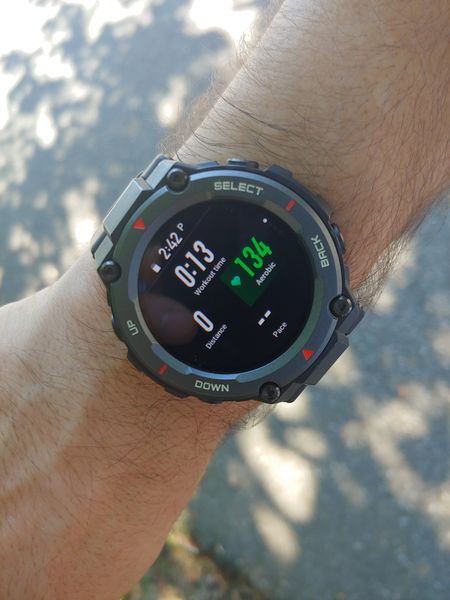
REVIEW – The Amazfit T-Rex was released in late 2019 and demonstrated the most rugged Amazfit watch ever created. A little more than a year later, Amazfit has released the Amazfit T-Rex Pro. The new watch has a bunch of sensor and durability improvements. I have one to review. Read on to see what I think!
What is it?
The Amazfit T-Rex Pro is Amazfit’s most durable activity tracking watch ever. It improves on the previous design by supporting four Global Navigation Satellite Systems, 10 ATM water-resistance, a blood-oxygen saturation measurement system, a compass and barometric altimeter, ultra-long 18-day battery life with typical use, and over 100 different sports modes. The watch pairs with an Android or iPhone and can receive notifications to alert the user and can also transmit sensor data to the phone so that sensor readings can be recorded and analyzed. While this phone does have some smart features, it is not capable of running applications that are not already part of the watch like a WearOS or iOS device. Overall, the watch is a budget-friendly design but does have a host of features found on some more costly options.
What’s in the box?
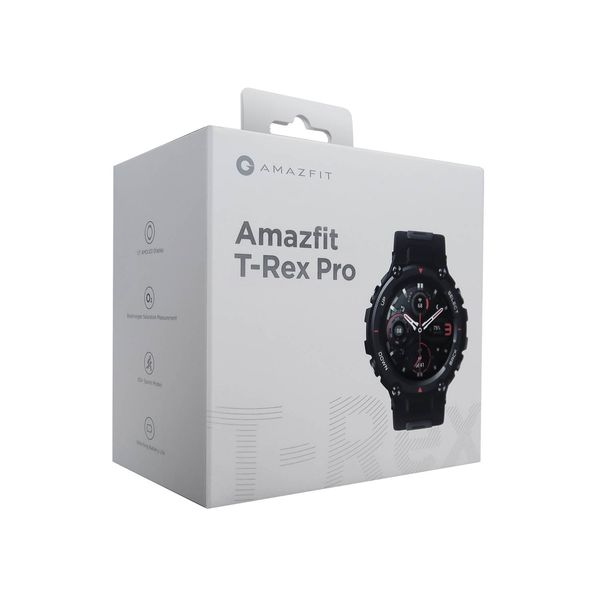
- Watch
- Instructions
- Charging Cable
Hardware specs
- 1.3″ HD AMOLED Display, Resolution 360 X 360, Always-on Display
- Bio Tracker 2 PPG Bio-tracking optical sensor
- 3-axis acceleration sensor
- 3-axis gyroscope sensor
- Geomagnetic sensor
- Ambient light sensor
- Barometric altimeter
- GPS+GLONASS, GPS+BeiDou, GPS+Galileo
- Bluetooth 5.0 BLE
- 390 mAh lithium-ion polymer battery (typical value)
- Charging time Up to 1.5 hours
- Magnetic 2-pins Pogo Pin Charger
- Typical usage: up to 18 days
- Heavy usage: up to 9 days
- GPS continuous working time: up to 40 hours
- RTOS Operating system
- Android 5.0 or iOS 10.0 and above
- Zepp App
- Dimensions 47.7 X 47.7 X 13.5mm
- Weight 59.4g (with strap)
- Body material Polycarbonate
- Strap material Silicone rubber
- Strap width 22mm
- Strap length 122mm (long), 78mm (short)
- Water-resistance grade 10 ATM
- Touchscreen Tempered glass + anti-fingerprint coating
Design and features
Unboxing
The Amazfit T-Rex Pro comes in a display box with an interior telescoping box, The display box has a picture of the watch on the front, details on the sides, and information about the contents of the box as well as minimum smartphone requirements on the rear. The interior telescoping box is white with Amazfit and the Amazfit logo printed on the top. Inside the telescoping box, the watch is presented on a stand made of molded cardboard. The charging cable is inside one side of the molded cardboard stand and the directions are inside the other. The directions are about a 1/4″ think but each language is only about 20 pages. The highlights are that the phone needs a 1 Amp current for charging and that pairing directly with the Bluetooth on the phone is not necessary or the proper way to pair the watch with the app.
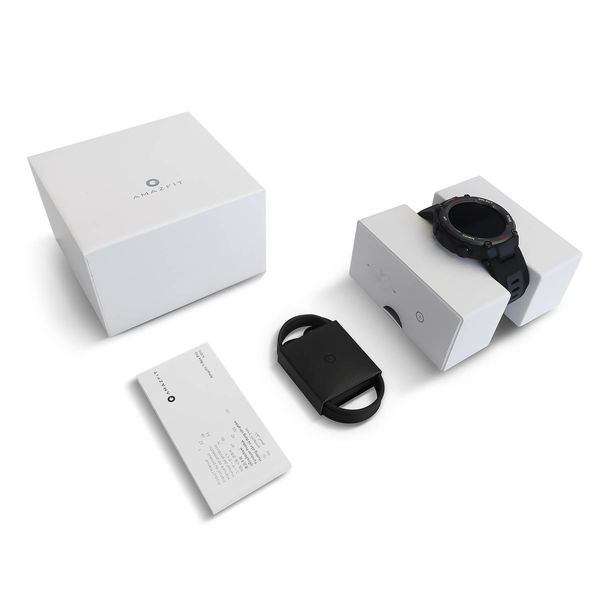
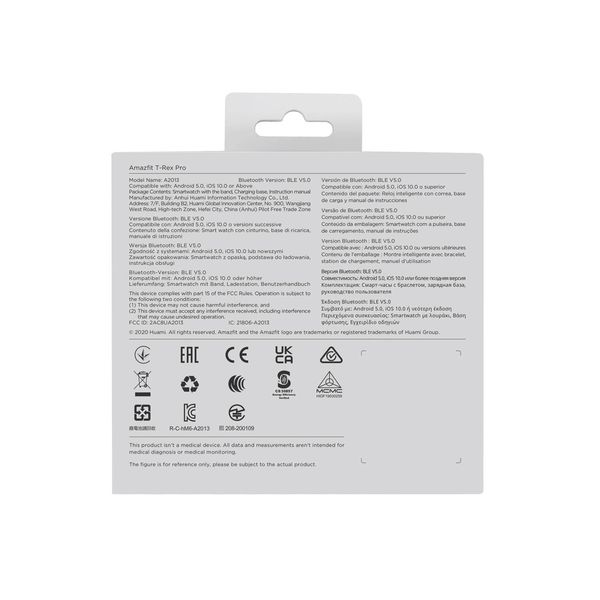
Setup
The official app for the watch is the Zepp app. Pairing the watch to the app involves the phone, with the app installed, taking a photo of the watch as it displays a QR code. It works quite well and is easy to complete.
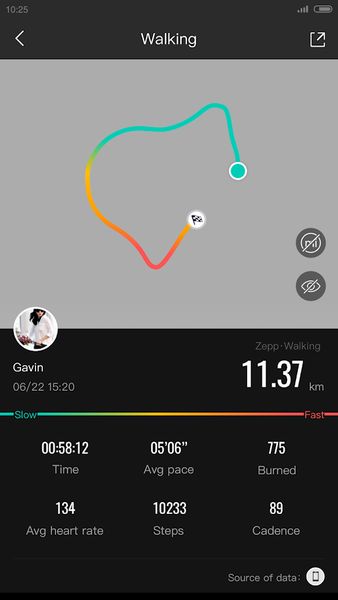
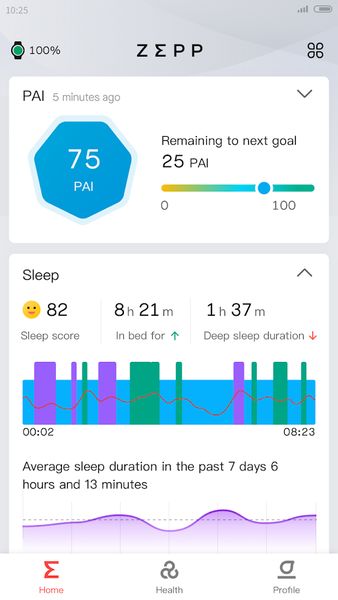
There are also alternative apps available on Android. I have been using an app called Notify for the Amazfit Bip for quite a while because I believe it provides better results for sleep, better access to notifications, and better access to data generated by the watch. If you are going to use Notify for the T-Rex Pro you will need to install the Zepp app as well, obtain a 32 character alphanumeric code from a website, query a rooted phone for the code, or download and install a modified version of the Zepp app that will provide a 32 character alphanumeric code.
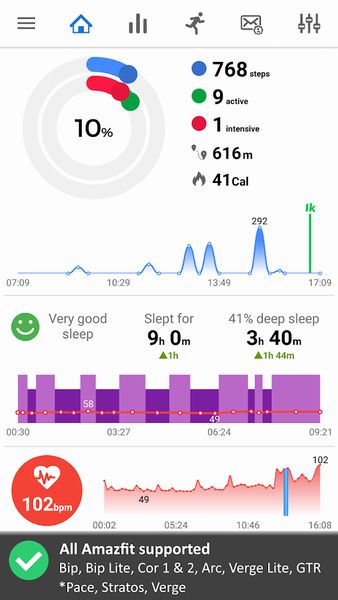
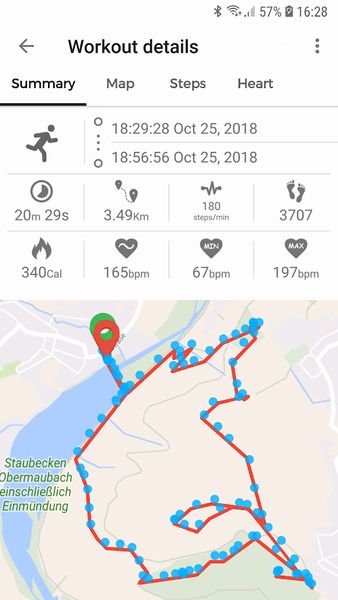
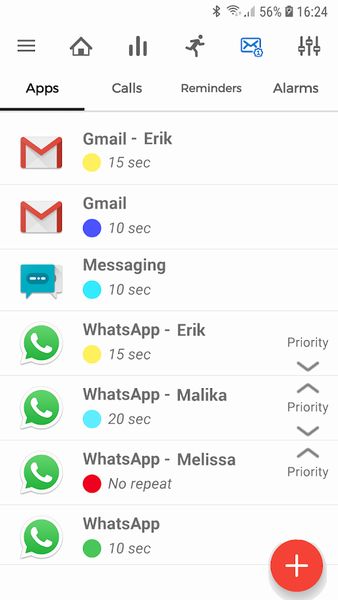
Design
The Amazfit T-Rex Pro comes in three colors: Meteorite Black, Steel Blue, and Desert Grey. I have the black watch to review. The front of the watch has a grey fixed bezel with the four button functions printed on it and red highlights that divide the watch into quadrants. Four screws with a triangular drive adorn the face along the top of the watchband. While the screws look legitimate (and not molded polycarbonate) I’m not sure what function they serve. The watch has a rugged look that Amazfit has backed with testing to demonstrate compliance with 15 aspects of MIL-STD-810G. The design is all polycarbonate but looks very tough and the material also makes the watch very lightweight.
The Amazfit T-Rex Pro is built tough with scratch-resistant and damage-resistant Corning® Gorilla® Glass 3 on its 1.3-inch HD AMOLED display. There are also glass screen protectors available for this design if that is preferred. The Display is very crisp with a 360 pixel count, which provides a 277 DPI resolution. The brightness of the screen is said to be about 350 nits and the glass can provide some glare, so it may be difficult to see the screen on a bright day, especially if a dimmer always-on display AOD is selected. An ambient light sensor around the 12 o’clock location allows the watch to maintain a comfortable brightness in most settings. The design of the graphics on the display is adjustable. A few options are stored on the watch and there are hundreds of more options available for free online, plus tools available online for free to create an entirely custom design.
The screen is a touchscreen and it is very responsive to swipes and touches. I feel one of the most useful features of the design is that the watch has four buttons that can be used to intuitively navigate all the screens and menus without having to touch the screen. This is useful if the screen is wet or if your hands are gloved. Button presses are firm but end with a noticeable click.
the strap is silicone and has a noticeable stretch to provide enhanced comfort. It is marketed as anti-sweat and that may be why the underside is ridged. I’ve worn silicone straps that have aggravated my skin before but this strap has not so I’m really happy with it. Unfortunately, I don’t see replacements for it marketed on the Amazfit/Zepp site, and if you would like to use another company’s strap the design of the linkage seems proprietary.
The backside of the watch has two green LEDs plus a red LED for SpO2. The optical sensor doubles as a sensor to determine if the watch is being worn and will turn off the LEDs if the watch is not being worn in a lit room the LEDs will not function. The backside also has a 1 inch diameter area that is pressed into the wrist for measuring and this gives the watch a good amount of surface area to transmit a vibe alert. The 1 inch diameter area also ensures that the watch is comfortable to wear, even when it is worn tightly.
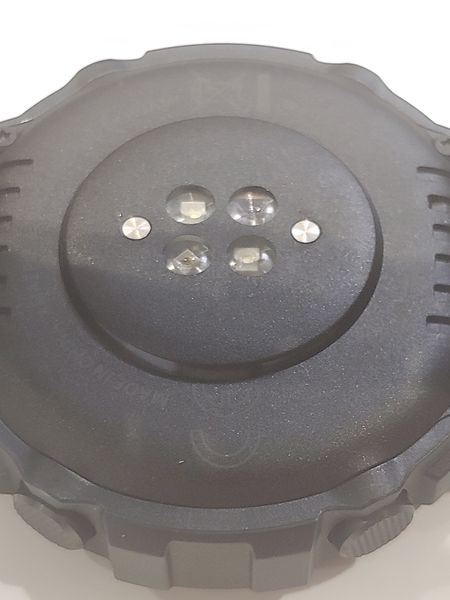
Operation
The Amazfit T-Rex Pro must be paired to a phone but there are a lot of features that can be accessed directly on the watch. The watch allows the selection of 3 different types of Global Navigation Satellite Systems (GNSS): GPS + GLONASS, GPS + Galileo, and GPS + BeiDou. The Watch can function as a barometer, compass, alarm, SpO2 meter, stress meter (measuring heart rate variability), a heart rate monitor, a stopwatch, a timer, measure the amount of time spent burning fat during the day, and also measure the number of times the user stands during the day.
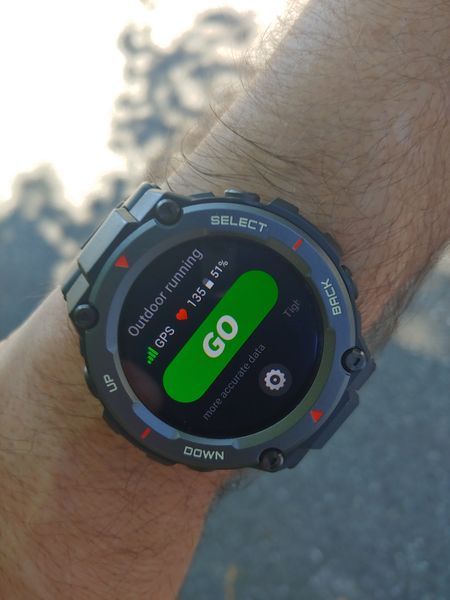
The watch also has a built-in flashlight of sorts, which turns the screen completely white on the brightest setting. This is actually a very useful feature. The watch has a battery saver mode that disables all recording except for steps and basic sleep tracking. The watch also has a theater mode that adjusts the screen brightness to the lowest level, disables wake on wrist raise, and turns of the always-on display.
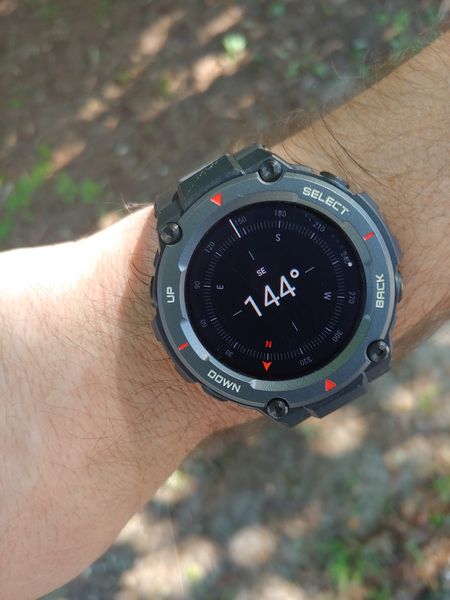
The Amazfit T-Rex Pro increases the number of sport modes from 14 to over 100. Many of the activities are just named activities that record the workout time, heart rate, and calories (such as archery). Outdoor activities also generally record the GPS position. Some activities record specific data. For instance, downhill skiing records the downhill, the current rate of descent, max speed, number of descents, and current altitude. Rowing will calculate the distance, speed, stroke rate, average stroke rate, pulling duration, and pushing duration. The swim function will determine distance, workout time, stroke type, laps, average pace, the Swolf score, calories, total strokes, average stroke rate, and distance per stroke. There are many more examples of unique metrics. On the running app, the energy intake, cadence assistance (which buzzes the wrist to allow the runner to keep pace), a virtual rabbit (to show the time difference relative to a virtual runner at a given pace), and a compass are all available. There are alerts available based on heart rate, distance, calories, pace, and time. Real-time graphs of heart rate, pace, altitude, and training effect are available. The workout can alert the runner when a certain metric is met during training as a goal.
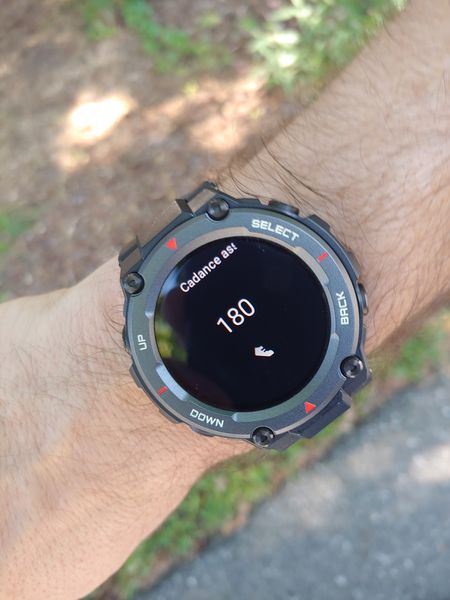
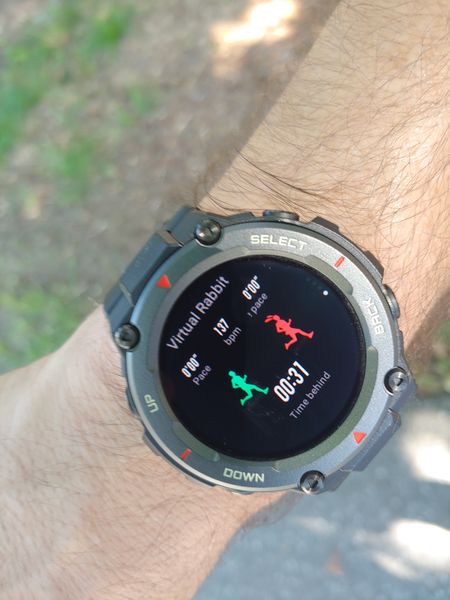
If the activity records the GPS location a trace of the activity will be displayed on the screen. However, the watch has no mapping ability so the GPS cannot be used to tell you where you are going and the trace is not accessible during the recording.
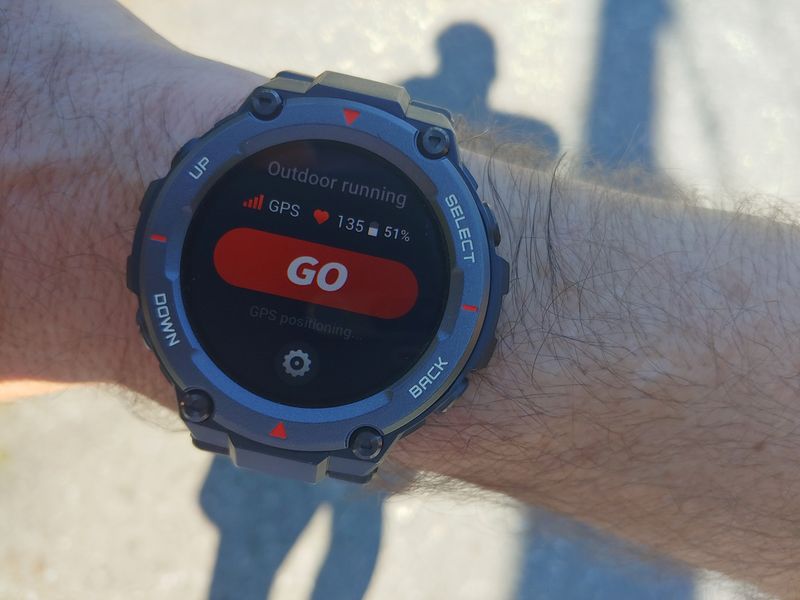
The watch also has PAI integration. PAI is a scientifically studied metric that is based on daily activity. Maintaining 100 PAI or more is strongly associated with adding on average 5 years to your life and reducing the risk of cardiovascular disease mortality by an average of 25%.
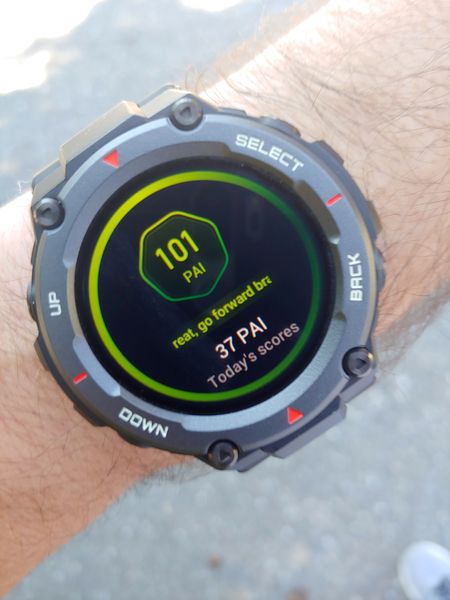
There are a couple of features that are specially designed to be used with a phone. The watch can locate the paired phone and will cause it to ring with an alarm that sounds like an air horn. This is guaranteed to help you find your phone unless you are at a hockey game. The watch can also be used to control music playback on the paired phone. Note that the watch does not have any memory available to store music nor does it have the ability to pair Bluetooth audio.
Besides tracking sport activities and telling the time the watch’s main other feature is providing an indication of the notifications that come up onto the phone. This is where, as you may have guessed by the app name, Notify has a much better implementation than the native Zepp app. If you have both applications installed then turn off notifications on the Zepp app and enable them on Notify. The Notify app allows an unbelievable amount of features and customizations to each notification. While the Zepp app only provides one-way notifications, the Notify app allows custom programming of the select button and music buttons. The programming is exhaustive:
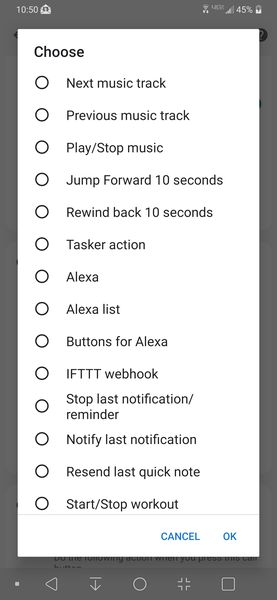

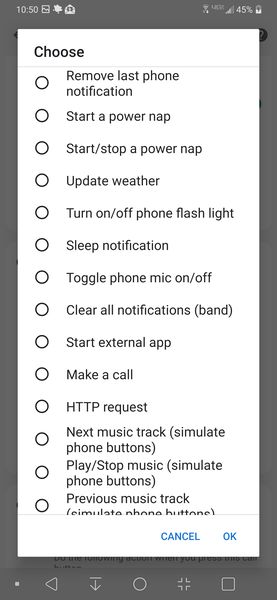
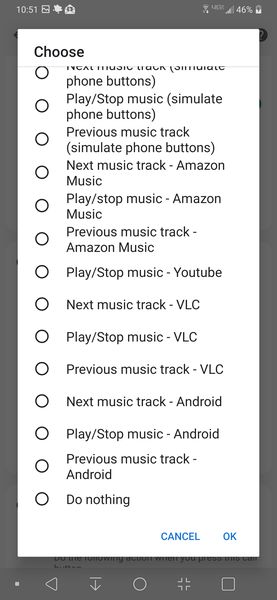
It also allows the music buttons to send preformatted responses to your messaging app, and it allows the responses to be customized to the recipient. If you would like to explore two-way communication from your watch, then Notify on Android will help bridge the gap between a Wear OS watch or an iOS watch and this watch.
The sleep monitoring must be parsed and calculated by a phone; the watch will not calculate a sleep score on its own. The Zepp and Notify apps both integrate the SpO2 readings into the sleep analysis to permit the phone to inform you if there is a chance that sleep apnea is causing low oxygen saturation levels at night. I found that the sleep duration was calculated more accurately on Notify than on Zepp. on a typical night, Zepp would calculate 3 hours of sleep while Notify would calculate 6.5. Both apps gave approximately the same score, oddly enough. Notify also can integrate with Sleep as Android, which isn’t a program I use but is an app that some people swear by. Notify also has a smart wake alarm feature, which will sound the alarm when it detects that you have entered light sleep less than 30 minutes prior to the set wake-up time.
Performance
One of Amazfit’s big selling points across most of their product line is the long battery life that each of their devices is capable of. While the battery life of the Amazfit T-Rex Pro may last up to 18 days with typical usage the number can be less than that depending on usage. Some things which may lower the number of days between charges include display brightness, notifications, GPS usage, custom displays, always-on display, SpO2, and heart rate monitoring. I found that the battery life was between 5 and 10 days depending on set up and usage. The best news is that a fully dead battery only takes about an hour to fully charge. The watch and charger both contain strong magnets to ensure a secure fit.
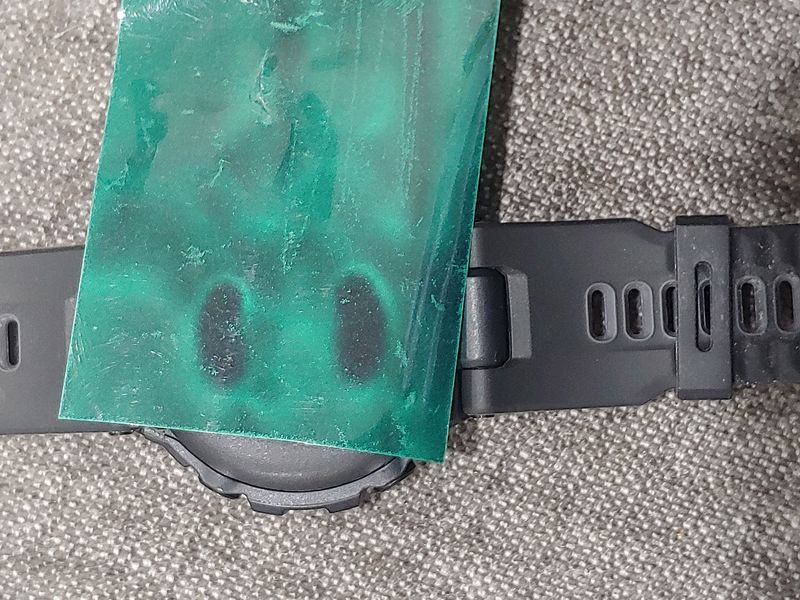
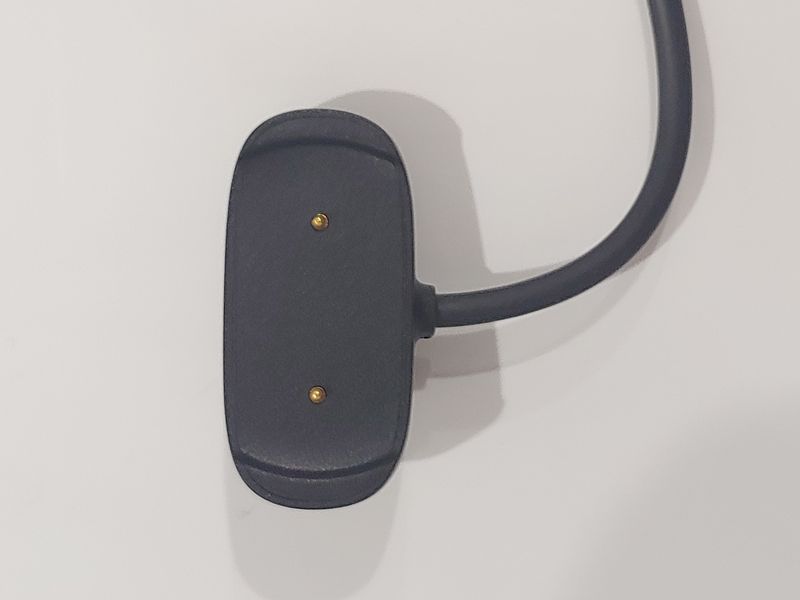
The GPS acquisition is pretty quick, and lasts between 5 and 25 seconds. The GPS can use 4 satellite systems to locate the watch. In general, the GPS is accurate and doesn’t have widely varying locations while on runs or hikes. A more accurate version of the GPS, known as 3D data mode, must be turned on to get the most accurate distance and pace data.
The heart rate accuracy was very precise when it worked. Occasionally, the heart rate will fail to be updated so that while doing HIIT, for instance, I will never warm up. But, when the heart rate seems to be accurate, the values it reports are very close to the values that I obtained with a chest strap. The feedback that is received with the heart rate sensor is pretty extensive, with results for training load, aerobic training effect, anaerobic training effect as well as recovery time.
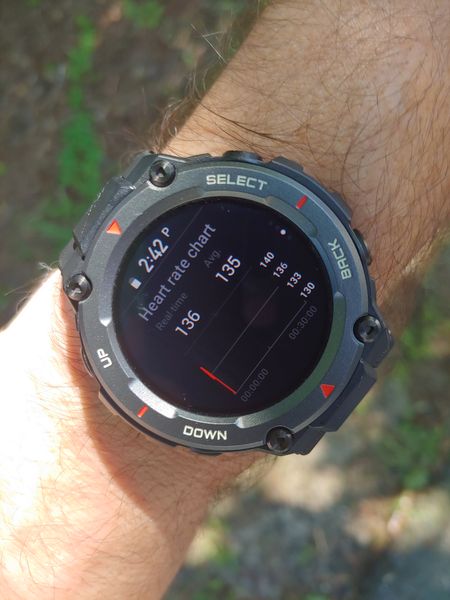
What I like
- Sensors
- feedback
- notifications
What I’d change
- availability of replacement watch straps
Final thoughts
In conclusion, the Amazfit T-Rex pro has a lot of features going for it. I feel it is a great-looking watch with design aspects that do not overemphasize the durable construction. The watch is a capable solo performer with an arsenal of sensors to record metrics and provide workout assistance. The health monitoring aspects of the watch include most of the sensors available on a wristwatch (except for perhaps electrodermal or galvanic skin response) and can provide alerts if recorded values are outside of normal. The notification capabilities of the watch are on par with many other smartwatches if using the Zepp app and superior to just about any other watch that lacks Wear OS or iOS if using the Notify app. For about the same or a little bit more money a Garmin Venu Sq, Garmin Forerunner 45, or a Coros Pace 2 can be had. Each of these has little features that differentiate one watch from another. The Amazfit T-Rex Pro stands out for its durability (100M water rating), customization (watch faces), and communication (2-way notification). I’ve been using this for a month now and absolutely love it. I suggest you see if this is the sports smartwatch for you.
Price:
Where to buy: Amazon and Amazfit
Source: The sample of this product was provided by Amazfit.

![[From INIU - the SAFE Fast Chage Pro] Experience the safest charging with over 38 million global users. At INIU, we use only the highest-grade materials, so we do have the confidence to provide an industry-leading 3-Year iNiu Care. [22.5W Speedy Char...](https://m.media-amazon.com/images/I/416nS4GRFtL._SL160_.jpg)

Gadgeteer Comment Policy - Please read before commenting
Good review. I owned many “smart” watches and latterly 2 Garmin Vivoactive 3s and these suffered battery declines to between 24-36 hours each. Then I bought an Amazit and get 7 – 11 days of full usage. with really no drop in the functionality I use. Highly recommend these watches.
My husband has been very pleased with this watch, but when we approached the company to buy a spare charger found out they do not offer that as an option. If the provided charger should fail during the first year they will replace it under warranty, after that you might as well toss the watch into the trash. We have been unable to find a 3rd party option.
no mention of accuracy which leaves me very skeptical.
The article does mention some comparative results for accuracy of the GPS and the heart rate sensor. Comparing GPS signals with GIS information or comparing heart rate data to EKG information is beyond the scope of this level of review.
I got mine on sale so it was less then half price of Garmin. I’m pretty pleased. HR is accurate. GPS is as well. Great inexpensive alternative. No regrets.